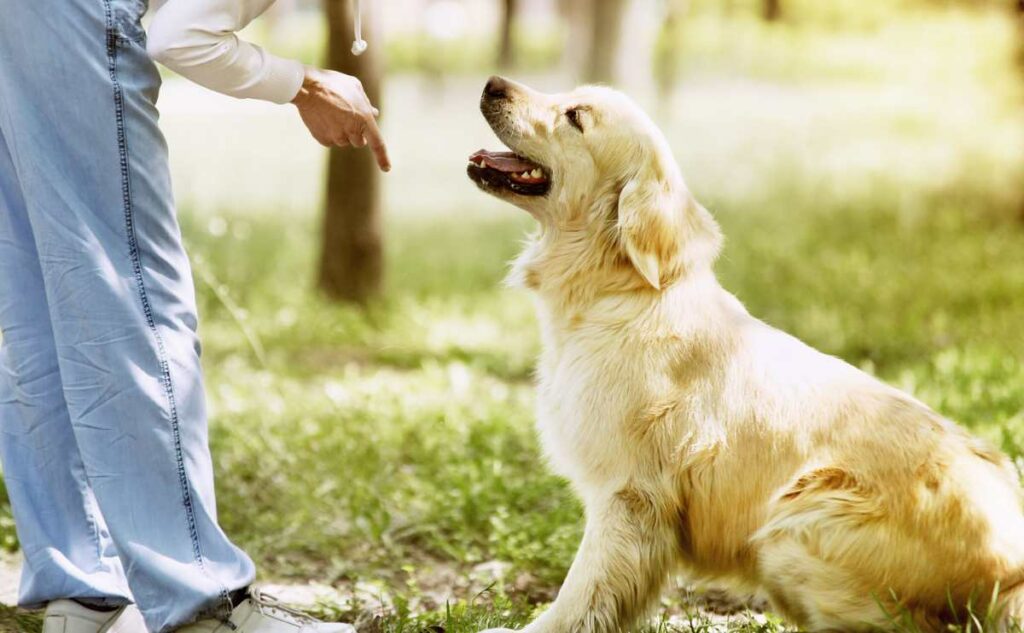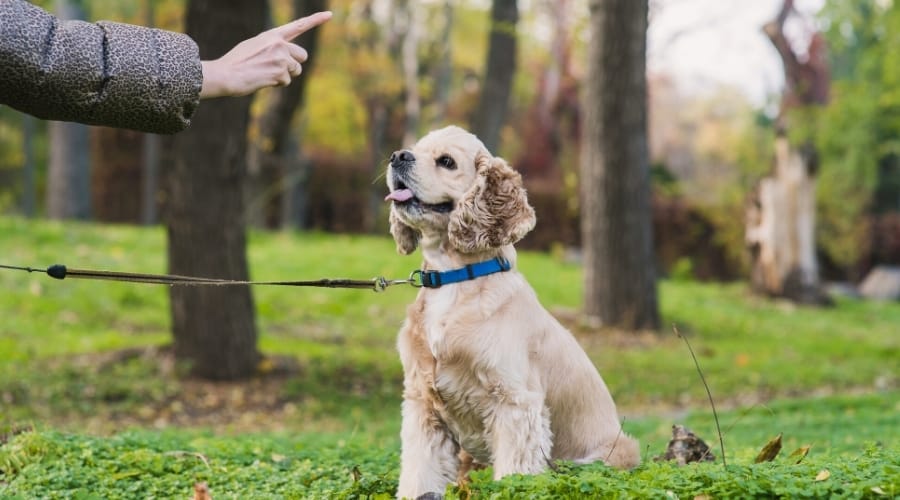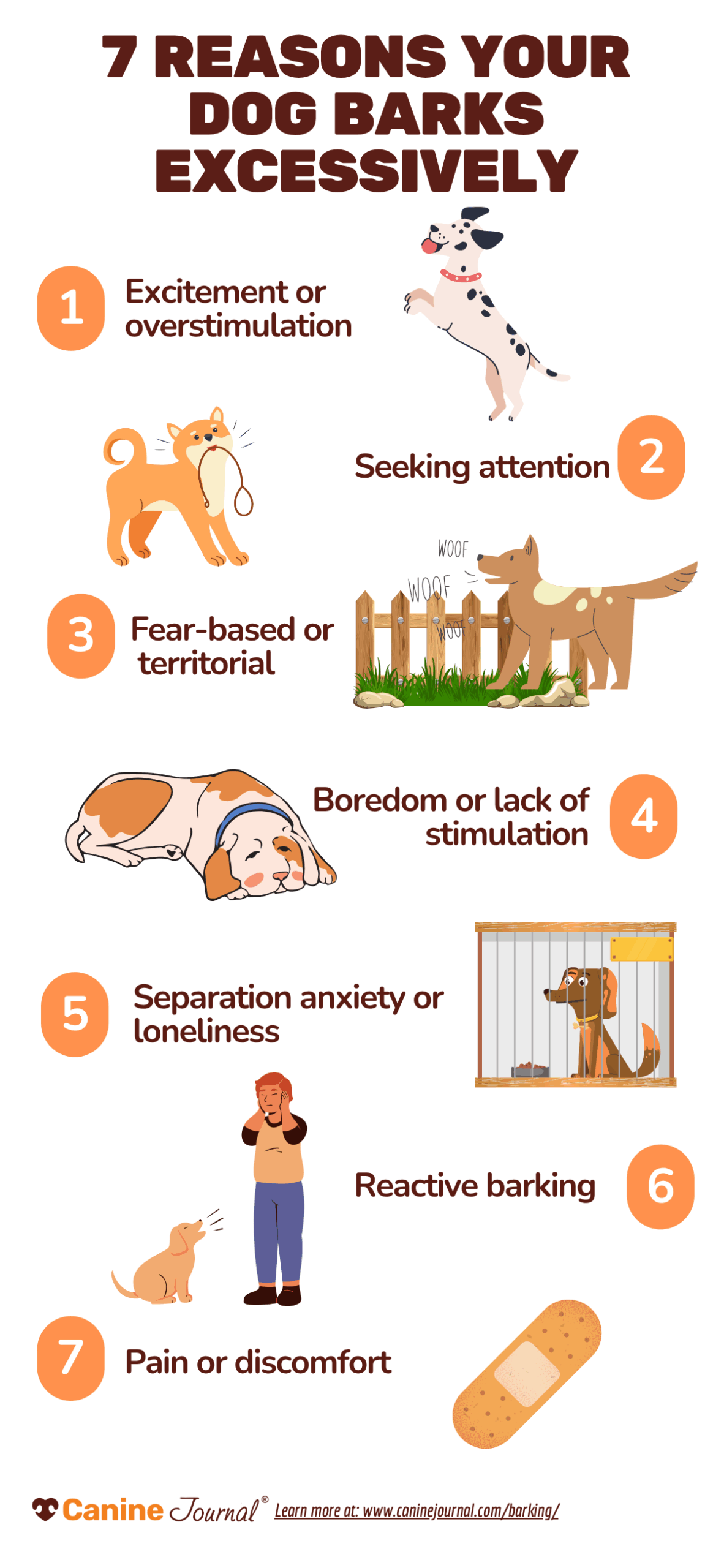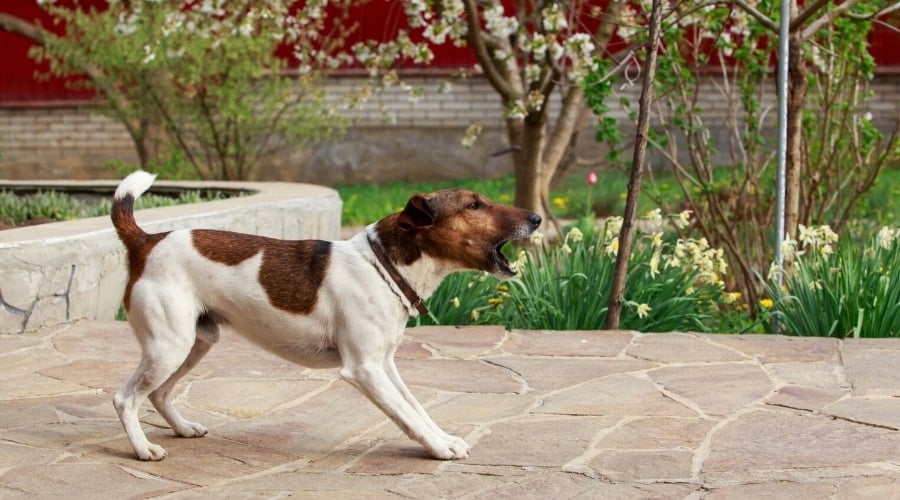Unlocking The Silence: 7 Real Reasons Your Dog Won’t Stop Barking
When you purchase through links on our site, we may earn a commission. Here’s how it works.
You’re enjoying a quiet afternoon in the yard. Birds are chirping, the water feature is trickling, and everything feels peaceful until Fido suddenly starts barking like crazy at what seems like absolutely nothing.
Table of Contents
Or maybe you didn’t even make it outside because your pup barks at everything all day long.
It’s frustrating. I hear you and your dog. And I’m here to help.

Barking is normal. It’s how dogs communicate. But nonstop, nuisance barking isn’t something you have to live with.
If you’re wondering how to get the barking under control, you’re in the right place. In this guide, we’ll explore why dogs bark, what causes excessive barking, and how to manage it with simple, effective solutions that actually work.
What You’ll Learn About Dog Barking Behavior
Barking is a natural form of communication for dogs, but when it becomes excessive, it can disrupt your home, frustrate neighbors, and signal deeper behavioral or emotional issues. In this guide, you’ll discover:
- The most common reasons dogs bark too much (and how to identify them)
- How to prevent excessive barking before it starts
- Step-by-step training methods, including the “Quiet” command
- Practical tips to correct different types of barking
- What to avoid when trying to quiet your dog
- When it’s time to seek professional help
Whether you’re dealing with an anxious pup, an attention-seeker, or a dog who barks at every leaf, this guide will help you restore peace and strengthen your bond with your furry companion.
Why Dogs Bark: It’s Their Way of Talking
Let’s be clear: dogs are supposed to bark. It’s not just noise; it’s how they communicate. Whether they’re chatting with you or another pup down the street, barking is their version of speech (just with more woofs and fewer syllables).
But here’s the twist: Not all barks mean the same thing.
Tone, pitch, frequency, and even the situation play into what your dog’s trying to say. Some dogs are naturally louder. Some keep it low-key. Just like people, really.
Myth: Some Dogs Just Bark for No Reason
Truth: Every bark has a trigger, even if it’s subtle. Whether it’s boredom, anxiety, reactivity, or hidden pain, barking is your dog’s way of expressing a need or concern.
Should You Stop Barking Entirely?
Nope. And you shouldn’t try.
Imagine if someone told you to stop talking forever. Frustrating, right? That’s what it feels like when we try to silence our dogs completely.
The real goal?
- Stop the excessive, nonstop barking.
- Encourage the useful kind—like alerting you someone’s at the door or when it’s potty time.
Too much barking can strain your relationships with neighbors, lead to fines (yep, it happens), or even violate rental agreements.

Barking Has a Purpose
Dogs bark for reasons that actually help us:
- Letting you know someone’s on the property? Helpful.
- Barking to go outside before an accident? Also helpful.
What you don’t want? Constant, frantic barking at nothing. That’s when it becomes a problem.
Balance Is Everything
The trick isn’t silencing your dog. It’s understanding why they’re barking in the first place. That’s your entry point. You can start steering them toward better habits once you figure out what they’re trying to say.
Because, in the end, a well-timed bark can be a beautiful thing.
Teach Your Dog the “Quiet” Command (Even If They’ve Ignored You Before)
Okay, so your dog’s barking a little too much, and you’re ready to get some peace and quiet. Good news: You can absolutely train your dog to stop barking on command. You just need the right approach and a little consistency.
Enter the “Quiet” command – your new best friend. This simple cue tells your dog, “Hey, I heard you. That’s enough.” And when you teach it correctly, it works like magic.

Teaching your dog the quiet command is integral to getting your dog to stop barking. Although you might think your dog is past this point, you’ll be surprised that it works with most dogs.
The best part is that you start by teaching them to bark, which they’re already good at. There are two steps to the quiet command.
- Teach Them Speak
- Capture the moment they bark, and repeatedly say the word yes and reward when they bark.
- This is easier to do when they’re in a happy state, such as playing. Do this repeatedly, and reward them.
- Once they do this consistently, you can say the word speak the moment before they bark. Over time, they quickly learn to speak.
- Teach Them Quiet. Now that you’ve got the speaking element down, you can teach them to be quiet.
- In between the speaking, say the word quiet.
- After a while, there will be pauses between the bark and reward.
- Once there are a few moments of silence, say quiet again and reward your dog.
After a while, you can reintroduce the speaking element as well and reward them when they speak. That way, they learn the difference between quiet and speaking.
- Remember to keep it positive and avoid using punishment. Dogs learn best when they feel safe and encouraged. If they associate “Quiet” with getting a treat (instead of getting scolded), they’ll be way more likely to cooperate.
- Plus, timing is everything here. The faster you reward that moment of silence, the more clearly your dog understands what you want. Don’t wait too long; they might think you’re rewarding the barking.
- Use high-reward dog treats for training, such as liver treats. My dogs go crazy for my DIY freeze-dried liver treats, and I share this recipe along with other favorite freeze-dried options.
Train Early: 5 Ways to Prevent Excessive Barking From The Start
Do you have a puppy or a newly adopted dog? You’re in the sweet spot.
This time is your golden window to shape lifelong behavior, including how, when, and why your dog barks.

1. Start Early, Stay Sane Later
The earlier you introduce boundaries and expectations, the easier it is to prevent barking before it becomes a habit.
It’s much simpler to guide a young dog than to unteach an older one.
2. Reward the Right Behavior
Here’s the secret: Only calm, relaxed behavior earns praise and treats. If you reward barking, even accidentally, you’re reinforcing it.
Don’t give in just because they’re cute. That adorable demand bark for attention or snacks? If it works once, they’ll try it again and again.
3. No Boundaries = Noisy Dog
Without clear limits, your dog may start thinking barking at every doorbell, squirrel, or leaf blowing in the wind is totally acceptable. Sound familiar?
4. Socialization Is Key
Early socialization does more than improve manners. It builds confidence.
- Expose your dog to:
- New people
- Different environments
- Noise (like vacuum cleaners or traffic)
- Everyday objects
The result? A more adaptable, less reactive dog—and far less barking.
5. What to Teach from Day One
Let your pup know:
- Barking to alert you is okay (within reason)
- Barking for attention every five minutes isn’t
Consistent training and clear communication are your best tools. When your dog knows the rules, they’re more secure and, usually, much quieter.
Myth: Bark Collars Are the Best Fix
Truth: Bark collars may suppress barking but rarely solve the root cause. Without addressing underlying triggers or teaching new behaviors, they often just silence the symptom, not the problem. Learn more about bark collars and how to use them in our detailed guide.
Top 7 Reasons Dogs Bark Excessively
Dogs can’t speak to us in our language. How easier would life be if they could? Think of your dog as a newborn baby. Babies cry when hungry, want attention, are ill, or are scared. Babies can’t tell their parents the problem; they can only make a noise. And for dogs, their noise is barking.
Let’s face it: dogs bark for all kinds of reasons. It’s not just random noise (even if it feels that way at 3 a.m.). If your dog’s barking has gone from cute to chaotic, it’s time to figure out what’s behind it.

Once you know the “why,” you can start tackling the “how” to stop it. Here are the 7 most common reasons dogs bark excessively, plus a peek at what each type of bark is trying to tell you.
1. Excitement Or Overstimulation
Excited barking usually comes with a waggy tail and wiggly butt. Spinning in circles or tapping their paws are also signs of excitement. They look alert, generally pleased, with their ears held high. Packs of dogs bark and howl when excited, and it’s just your dog’s way of saying they’re happy.

Examples of excited barking are when you come home after work or say the word ‘walkies.’ That zoomies-fueled barkfest when you grab the leash? Yep, excitement barking.
This type of barking only lasts a minute or two at most or until the desired outcome happens. For example, when you pay them attention or take them out. Usually, excited barking is rarely an issue because it is normal and short-lived.
Signs include:
- Waggy tail, spinning in circles, paw tapping
- Barking when you say “walk” or grab the leash
- Short bursts of barking that stop once they get what they want
- Quick fix: Practice calm greetings. Ignore them until they settle, then reward the calm.
- Redirect idea: Teach a “sit and wait” command before things that trigger excitement, like grabbing the leash or opening the door.
2. Attention-Seeking Behavior
Barking is how dogs communicate. If your dog is barking for attention, the barks are usually short, sharp, and monotone. There is usually a pause between each bark, giving you a chance to react.
Their body language is usually more relaxed, with a slow wagging or stiff tail and natural ears. Examples of this could be barking because they want to be stroked or need a pee or poop break outside.
Typical traits:
- Short, monotone barks with pauses
- Relaxed body, slow wagging tail
- Happens when you’re busy, on the phone, or ignoring them

This type of barking can be problematic depending on why your pup wants attention and whether you give it to them. For example, barking because your pup needs to pee is good and should be acted on. You could also try bell training for toilet needs.
But if your pup is barking because they want a treat, and you give them a treat, you are rewarding that behavior. And you can be sure they’ll do it again and again.
Just like if your pup barks when you’re on the phone, cooking, or not giving them the spotlight, they’ve learned that barking gets results. Even scolding can feel like attention to them.
- Quick fix: Don’t reward the bark. No eye contact, no talking, no reaction. Wait for silence before engaging.
- Redirect idea: Teach an “all done” cue. Use it consistently to end play or petting so they learn barking won’t restart the fun.
3. Separation Anxiety Or Loneliness
This barking type is common for dogs who are bored and anxious at home while their family works all day. If your dog goes into bark-overdrive the moment you leave, it might be separation anxiety. This kind of barking usually sounds distressed and can go on for hours (sorry, neighbors).
This barking often:
- Starts the moment you leave
- Sounds panicked or includes howling
- Is paired with signs like trembling, pacing, or droopy ears and tails

You might not be aware of this problem until your neighbor or indoor camera alerts you to the problem. It might not be a problem for you, but it can be a big problem for your neighbors that needs solving fast.
This type of barking is your dog’s way of calling out to anyone who can hear them because they want comfort.
- It could be consistent, loud, and proud throughout the day if they are barking because they are anxious.
- Some dogs howl, and some mix it up with both barking and howling to keep everyone on their toes.
- Anxious dogs often drop their ears and tails and look generally uneasy.
- Trembling is also common for severely anxious dogs.
If you suspect your dog is barking out of anxiety, why not check out our calming treats for dogs to see if this simple solution helps the issue?
- Quick fix: Leave behind a puzzle feeder or lick mat with frozen peanut butter to distract them when you leave.
- Redirect idea: Practice short absences such as stepping outside for one minute, then gradually increase the time away.
4. Fear-based or Territorial Barking
Barking at the mail carrier, the UPS truck, or anything that dares approach the front door? Classic territorial barking. It’s your dog’s way of saying, “This is my turf!”
This is a defensive barking style, and it is usually caused by a stimulus. For example, they might bark because a stranger is walking towards their family or doing something they shouldn’t be doing.

If they are barking because they are territorial, their head and tail usually rise, making them appear larger and stronger. A growl and bared teeth warn that they are ready to bite and that whoever or whatever is annoying them should back up.
Their barks are likely loud and proud, acting like the alpha male. This is potentially problematic if they are constantly being territorial.
It could also be a reaction to loud, scary noises or something they have never heard. This is your dog’s way of telling you that you both need to be ready for this potential problem. Fearful barking is deeper and louder in sound and is usually continuous and excessive until the stimulus is removed.
Look for:
- Barking at strangers, mail carriers, or cars
- Raised tail, stiff posture, growling or showing teeth
- Barking that doesn’t stop until the person or noise leaves
If they are fearful or unsure of the stimulus, there might also be an aggressive growl in there for good measure. Their unsure body language usually includes low head posture, raised hackles, and holding their tail between their legs.
- Quick fix: Block their view of common triggers. Window clings, curtains, or repositioning furniture can help.
- Redirect idea: Train a “thank you” cue. Acknowledge the alert, then redirect with a treat or task to show they did their job.
5. Boredom Or Lack Of Stimulation
This type of barking is one of the most common reasons dogs bark. If a dog is mentally or physically unstimulated, they often bark or howl to entertain themselves. This is their way of sighing or telling us they’re fed up. This type of barking is straightforward to correct.
Excessive barking from boredom is usually the precursor to problematic behavior, so you must address it quickly. The simple mantra here is that a tired dog is a happy dog.
You might notice:
- Barking or howling in long stretches
- Play bows, toy carrying, or bringing things to you
- Short gruffs or howls to prompt play

Some dogs bark, and others might gruff rather than bark. Like attention-seeking, they want your attention and to play with you. The barks or gruffs are short, with gaps in between to allow you to play. Or if they are super bored or a natural howler, they might howl, too.
To make it obvious, some pups might carry their toy over to you. And some play bow (front legs down, booty in the air) to let you know they are ready for action.
A flirt pole is a great way to play with your dog and a simple way to physically and mentally stimulate them.
- Quick fix: Rotate toys daily. A “new” old toy can spark fresh interest.
- Redirect idea: Add a 10-minute sniff walk to your routine. Letting them explore smells is mentally satisfying and naturally calming.
6. Reactive Barking
This is another common reason for excessive nuisance barking, and a stimulus always causes it. Some dogs are super sensitive to triggers like passing dogs, bikes, or loud noises. These pups tend to bark as a knee-jerk reaction to stimuli, which is known as reactive barking.
Often confused with fear or territorial barking, this can include:
- Barking at people or animals passing by
- Barking at vacuums, sirens, or household sounds
- Barking that stops when the stimulus disappears

For example, your dog might be barking at a cat sitting up a tree in your yard. Or they could be barking at someone or something walking past their house. It’s their way of saying, ‘Hmmm, I’m not sure how to handle this situation,’ or they want to investigate it further.
Reactive barking is loud and continuous and usually won’t stop until the stimulus is removed. It’s very similar to the fear and territorial barking, but not necessarily because they want to guard you or feel fearful. It could also be that they think it’s a game and want to join in.
- Quick fix: Avoid stacking stressors. If your dog has already had a long, overstimulating day, choose a quiet route or delay the walk.
- Redirect idea: Try counter-conditioning. Reward them with treats the moment a trigger appears, before the barking starts.
7. Pain Or Discomfort
This type of barking usually occurs during play or fighting, resulting from pain or shock from what has just happened. If your pooch is in pain, they do whatever they can to tell you. This is their way of shouting out, asking for assistance, or informing the other dog or human to stop what they are doing.
You see this a lot with puppies learning how to play and testing how hard they can bite their littermates without hurting them.

You can usually tell the difference between this type of barking and all other types because it genuinely sounds like they are in pain. The bark is typically high-pitched or whimper-like and usually stops after a few barks.
You may hear this:
- During play (especially with puppies)
- After bumping into something or being accidentally stepped on
- If an injury or chronic condition flares up
If your dog suddenly starts barking more than usual, especially without an obvious trigger, they might be trying to tell you something’s wrong. Don’t ignore this kind of barking; it could be a sign of pain, injury, or illness.
- Quick fix: Watch for sudden changes in barking, especially when paired with limping, licking, or hiding.
- Redirect idea: Book a vet check if barking seems out of character or persists without a clear reason.

Myth: My Dog is Just Being Dominant
Truth: The dominance theory is outdated and inaccurate in most barking cases. Modern research from the American Veterinary Society of Animal Behavior (AVSAB) points to fear, stress, and unmet needs, not pack leadership struggles, as the root of most problem barking.
5 Effective Ways To Correct Barking Habits
Alright, so you’ve figured out why your dog is barking, and maybe you’ve even started working on the “Quiet” command (go you!). Now let’s talk about how to correct those barking habits, especially when they’re happening on repeat.
If you are looking to curb bad habits, the good news is that there are steps that you can take for each type of barking. Different barking triggers call for different strategies, so here are five proven ways to stop excessive barking based on the root cause.
Most of the steps to correct barking behavior are similar, and they should be done in a way that does not upset your dog or cause any mistrust between the two of you. Let’s look at how you can end this annoying behavior before it gets out of hand.
1. Boredom Barking: When Your Dog Just Can’t Deal With Downtime
If your dog barks out of boredom, they simply need more stimulation, such as indestructible dog toys, chew sticks, interactive games, and more exercise. Many dog owners make the mistake of saving their exercise after returning home as a treat to look forward to.
But Fido’s brain isn’t wired that way. Instead, exercise them vigorously before you leave them. This way, they’ve already burned their excess energy, leaving them with less energy for barking.

But what about if you are working all day and aren’t there to address it? Unfortunately, something needs to change unless you want more problems on your hands. Is working from home or mixed hours an option?
Or maybe you could ask a friend or a neighbor to go in and play with them for a little while. If not, you need to hire a dog walker or take your pup to doggy daycare.
2.”Look at Me!” Barking: The Attention Game You Didn’t Know You Were Playing
This is one of the simplest barking correction methods. However, it is usually the one people struggle with the most because owners feel guilty for ignoring their barking pooch. Whether barking to get you to play or barking because they don’t want to be in the crate, all barking dogs require the same treatment: ignore them.

Negative attention, such as telling them off or to be quiet, is still attention. So, ignore them until they are calm. Otherwise, you are simply rewarding them for barking despite wanting them to stop.
- If you know that your dog doesn’t need a pee break or water, wait until they are quiet. Once they have shown you that they can be silent, reward them by letting them out and giving them attention.
- The trick to this correction is consistency and a strong will. You must show your dog that quiet wins rewards, not barking. This may take a while, especially if they are used to you coming to them when they bark.
If, after a while, it still isn’t working, try giving them something to do to occupy them, such as a toy. Pay them attention when they are playing with the toy rather than barking.
3. Reactive Barking: When Every Noise Sets Them Off
This is one of the most difficult barking problems to correct because reactive barking is usually your dog’s natural reaction to something or an ingrained reaction that has never been challenged before. Like before, you need to be consistent and stronger-willed than Fido.
Remember that reactive barking always starts with a stimulus, so you must figure out the stimulus.

For example, say your pooch barks at passersby when sat by the window. Now, you can’t stop people walking past your house, but you can install a blind or set of curtains to block their view. Remove the stimulus, and you should prevent the barking.
- If your dog barks at that pesky cat up the tree, call your pooch inside as soon as they begin to bark. It sounds simple enough, but you must act quickly to create the desired effect.
- If your pooch is barking at visitors or the doorbell, you need to remember that you probably don’t want to stop them from barking completely.
- Ideally, you want your dog to bark once to alert you, then back off and let you deal with it.
Watch this informative video on how to stop your dog barking at the front door by desensitizing them.
4. Anxious & Alone: Barking That Comes From Missing You
The first tip is to always leave your puppy alone for short periods during puppyhood. Otherwise, they become dependent on your constant company. Start with 15 minutes, and gradually increase it until you can leave them alone for a few hours.
Never leaving your puppy’s side is the leading cause of separation anxiety, and it can be challenging to correct this.

However, this is no help if you are trying to correct the excessive, lonely barking now. This issue also ties in with boredom when you are not there. So, always exercise your pup vigorously before you go out to leave them feeling tired. Leave them with toys and activities to keep their minds occupied, too.
More often than not, this can solve the problem altogether. If it doesn’t, your pooch is probably anxious that you are not there.
- Invest in a crate and spend time crate-training your pooch. Once they are comfortable with their new crate, always reward them for being relaxed and quiet when inside.
- You should also consider hiring a dog walker to take your pup out halfway through your absence or dropping them off at a doggy daycare center. Even if it is a few times a week rather than every day, they are less likely to be bored and bark all day long.
- You can also try turning on a familiar sound to comfort them, such as the radio or the television. There are many benefits of playing music for your dog.
5. Fear-Based Barking: What Your Dog’s Telling You (Without Words)
Training out a dog’s natural reaction is often tricky but not impossible. If you can change their way of thinking, it can immensely improve your life and your dog’s life.
Correcting fearful barking takes time and patience. Never scold a dog for being afraid because it might make matters worse.
Sometimes, dogs are not barking out of fear. Instead, they might only be barking at a once-feared thing because they are just used to barking.

If your dog is scared of, say, the vacuum, leave it out in the room.
- Let your dog sniff and investigate it for a few days. Treat them when they go near it.
- Then, turn it on, leave it stationary, and let them explore it again.
- Your dog will probably bark at this point but try using the quiet command.
- Make the interaction with the feared stimulus as positive as possible. This method slowly desensitizes them and makes them realize there is nothing to fear.
Sometimes, things are scary for no reason. Like some humans, nothing can convince them that house spiders or the dark are nothing to fear. The same goes for Fido and their seemingly strange phobias.
If you cannot convince them that the stimulus is not scary, avoid it when possible. If it’s impossible, you should speak to a qualified canine behaviorist.
Our Personal Experience With (Mostly) Overcoming Excessive Barking
My dog Daisy is a reactive barker. As she has gotten older, she has developed dementia, which has only made the problem worse. Her more significant triggers are the doorbell and when someone knocks on the door. She is also a fence sergeant and will bark fairly aggressively at anyone on the other side of the fence, even if she knows them.
Daisy is a very muscular Pitbull Labrador mix, weighs about 80 pounds, and looks more like a polar bear than a dog. Her intimidating appearance, coupled with the insane barking, undoubtedly gives her a reputation as an aggressive dog.
Despite having six-foot-tall wooden fencing, I have had issues with my neighbors over Daisy’s barking. One man, who has lived next door to me for almost a decade, stopped talking to me one day after she barked at him for mowing his lawn. He was very upset about it and said he hated going into his own backyard because of her barking.
Obviously, I had to address the issue right away. After consulting the vet, I started Daisy on medication to calm her down and help temper her anxiety. I also started exercising her very early in the morning to tire her out, and stayed outside with her when she was in the backyard. When she barked at the neighbors, I would use the “leave it” command and give her a treat when she stopped barking and walked away. This multi-faceted approach helped quite a bit, but she still barks like a lunatic whenever anyone is at the front door.
– Danielle DeGroot, Rescue Dog Parent, Canine Journal Research & Writing
What NOT To Do When Your Dog Won’t Stop Barking
When your dog barks nonstop, and your patience is running on fumes, it’s tempting to try whatever gets them to be quiet. Even if it’s not exactly dog-trainer-approved. But here’s the thing: some common “solutions” actually make the barking worse.
Now that you know what to do with an excessive nuisance barker, here are the two things you need to avoid at all costs. Doing any of these things can worsen matters and cause even more barking. In addition to educating Fido, you need to educate yourself

1. Don’t Yell At Your Dog
This is the most common mistake that dog owners make when trying to stop excessive barking. You’d think that telling a dog off for barking would make them stop, but no. Fido’s brain isn’t wired like that.
- Remember, your pup cannot understand what you are saying. And they think you’re shouting with them, leading them to believe their ‘shouting’ is acceptable.
- Positive reinforcement training is much more effective at teaching better habits than punishment. So, ignore the barking and reward your dog when quiet and relaxed.
- Never, ever yell or scold a dog for barking.
2. Don’t Accidentally Reward The Barking
Another mistake dog owners make is to praise their dogs for barking. This is a big no-no. Petting your pooch to ‘calm them down’ is seen as praise to them. Yup, your pup thinks, “Oh, barking works! I’ll do it more!” It boosts their ego so that they can carry on barking.
Instead, reward only the moments when they’re quiet or calm, and ignore them when they bark. It may feel weird to totally ignore them mid-bark-fest, but trust me, silence is golden (and treat-worthy).
4 Extra Tips To Curb Persistent Barking
Still dealing with nonstop woofing, even after all the training and treats? Don’t worry. You’re not out of options yet! Sometimes, managing chronic barking behavior means pulling out a few extra tools from your dog-parent toolbox.

Here are four additional strategies that can help tame the barking beast when nothing else seems to stick. They might work on their own, or they are often effective when using them in addition to the barking training above.
1. Use Familiar Sounds To Desensitize Your Dog
Dogs are creatures of habit. If you know your dog barks when you are out, try using a familiar sound to distract or calm them. Sometimes, it’s the silence that drives dogs crazy, not the loneliness. Put the radio or the television on when you leave.
The sound of human voices and calming music can be enough to ease the tension and reduce barking.
Alternatively, some dog owners find success with a doggy monitor. This is similar to having a CCTV system inside your home designed for you to interact with your pooch while you are gone. Some systems, such as Petcube and Furbo, even dispense treats.
Remember to only speak to Fido when they are relaxed and calm. Otherwise, they might keep barking until they hear your voice.
If your dog barks at specific sounds (like the doorbell, vacuum, or garage door), they might need some sound desensitization training. Here’s how:
- Play a recording of the trigger sound at a low volume
- Reward your dog for staying calm
- Slowly increase the volume over time as they get more comfortable
This teaches your pup that those “scary” or “exciting” sounds are no big deal.
2. Try Gentle Noise-Correction Techniques
The noise correction techniques are saved for owners who cannot distract their pooch or redirect their barking behaviors with toys or other activities. If Fido completely ignores you despite your commands or silliest voice, you need the help of something more distracting. It needs to be something other than your voice and something that startles them so they cannot ignore it.
- Find something that makes a loud, startling noise, such as a horn or a tin can filled with coins.
- Rattle it as soon as your pooch barks, and the noise disrupts the barking.
- Sometimes a loud clap or a sharp “shhh” noise works, too.
- When they look at you, you can use your quiet command and treat them when they obey your instructions.
Although this doesn’t follow positive reinforcement training, it might be the only way in some circumstances. Some pet parents have had success using these safe, humane, sound tools to interrupt the bark cycle. Remember, use these sparingly and never to startle or scare. The goal is to distract, not punish.
3. Consider An Anti-Bark Collar (As A Last Resort)
Some canine experts use anti-bark collars to prevent barking, and we have a comprehensive guide on the best bark collars for dogs of all sizes. There are three types of anti-bark collars:
- Shock Collars
- Citronella Collars
- Sonic Collars
They act similarly in that they trigger a response when the dog barks. They either shock, release an unpleasant spray or startle them with a sound. Citronella spray is harmless, but the substance is unpleasant. Ideally, you should only use them as a last resort when other training methods do not work, as they do not deal with the underlying cause.
These can be useful for certain dogs, especially when paired with training and behavior modification. But they’re not a one-size-fits-all fix, and some dogs can become anxious with their use. I recommend talking to your vet or a trainer first to see if it’s the right fit for your dog’s barking problem.
4. If All Else Fails, Call In The Experts
If you have tried all of the above and your pup still shows no sign of giving up the barking ghost, it’s time to call in the experts. Sometimes, the cause of excessive barking is so deep-rooted that it requires someone with extensive knowledge and training expertise to deal with it.

If you cannot link your dog’s barking patterns, there could also be a chance that it is caused by an underlying medical concern, such as dementia. Learn more about doggy dementia and ways to tackle it.
Nuisance barking is not only annoying, but it also affects your and Fido’s quality of life, as well as everyone else around you. So, it’s worth the time and effort to resolve it. Finding the right dog trainer can be tricky, especially when there are so many to choose from, and not all are up to the job.
Learn how to find the right dog trainer for your needs and the best online dog training options. A professional can:
- Spot subtle patterns or triggers you might miss
- Create a custom training plan
- Help you feel more confident handling the barking
Sometimes a fresh set of eyes (and a little expert backup) makes all the difference. Whatever the rhyme and reasoning for your dog’s nuisance barking, do not feel like you have failed your pup in any way by speaking to a professional. Sometimes, things are just the way they are.
Getting in touch with a certified dog behaviorist is the best thing you can do for your pup and everyone’s quality of life. When searching for a trainer, be sure to do your research and find out whether your dog insurance covers training costs. Work with a trainer who uses positive reinforcement-based training and has verifiable qualifications.
Myth: Older Dogs Can’t Learn to Bark Less
Truth: Dogs of any age can learn new behaviors. With positive reinforcement and consistency, even senior dogs can adjust their barking habits and thrive with mental stimulation.
Frequently Asked Questions
If your dog’s barking feels endless or confusing, you’re definitely not alone. Below are answers to some of the most common questions dog owners ask about excessive, constant, or seemingly random barking. If you don’t see yours, let us know in the comments, and we’ll find the answer for you.
Why Is My Dog Constantly Barking?
If your dog is constantly barking, it’s usually their way of communicating something important. Common reasons include boredom, anxiety, excitement, or a response to outside triggers like people, animals, or unfamiliar sounds.
In many cases, dogs bark to get attention or to express that they need something, like food, a walk, or mental stimulation. Observing when and where the barking happens can help identify the cause, making it easier to address the behavior through training and routine changes.
What Causes Excessive Dog Barking?
Excessive barking in dogs is typically a sign that something is off in their environment or routine. It can stem from a lack of physical exercise, not enough mental stimulation, fear, separation anxiety, or even health-related discomfort.
Dogs may also bark excessively if they’ve learned that barking gets them what they want, whether that’s attention, food, or play. It’s important to first understand what’s triggering it to reduce excessive barking, then use positive reinforcement and training to redirect the behavior.
Is My Dog Barking For No Reason?
It might feel like your dog is barking for no reason, but there’s almost always a trigger, even if it’s something we humans can’t detect. Dogs have incredibly sensitive hearing and smell, and they often react to things we can’t see, like distant noises, unfamiliar scents, or subtle changes in their environment.
If barking seems random or frequent, try tracking the context and timing. This can help uncover a hidden pattern or consistent trigger that you can work on managing.
How Do I Stop My Dog From Barking Continuously?
If your dog is barking continuously, it’s important to respond calmly and consistently. Start by teaching the “quiet” command and reward your dog when they stop barking, even for a moment. Avoid yelling or giving attention during barking, as that can reinforce the behavior. Instead, redirect their energy with toys, exercise, or mental enrichment.
If the barking persists, rule out potential health issues with your vet. A combination of structure, patience, and positive reinforcement usually leads to lasting results.
Why Do Dogs Bark Constantly?
Dogs bark constantly when they’re trying to communicate something or when they’re experiencing emotional or physical discomfort. This behavior can result from boredom, loneliness, fear, anxiety, or excitement. In some cases, dogs bark out of habit because it has worked for them in the past.
To reduce constant barking, look at your dog’s daily routine, level of physical activity, and emotional well-being. Small changes like increased playtime, more consistent training, or calming routines can make a big difference.
Are Some Dog Breeds More Likely To Bark Excessively?
Absolutely. Some breeds are just born chatty.
Breeds like Beagles, Chihuahuas, Yorkshire Terriers, Miniature Schnauzers, Dachshunds, and Huskies are naturally more vocal. It’s not a flaw. It’s part of their DNA. Many of these dogs were originally bred to alert, herd, or guard, so barking was literally part of the job description.

Why Certain Breeds Bark More
- Beagles & Dachshunds – Bred for hunting; barking was used to signal prey.
- Chihuahuas & Yorkies – Tiny watchdogs with big attitudes.
- Miniature Schnauzers – Naturally territorial and alert.
- Huskies – Talkative and expressive, often “howling” as well as barking.
What This Means for You
If you’ve got a naturally vocal breed, it doesn’t mean barking is uncontrollable, but it does mean you’ll need:
- More structured training
- Extra mental and physical stimulation
- Realistic expectations
Understanding your dog’s breed tendencies helps you tailor your approach and set goals that actually make sense for your dog, not someone else’s golden retriever.
Bottom line: You can’t change a dog’s instincts, but you can teach them when it’s okay to speak and when it’s time to be quiet.
Other Ways To Improve Fido’s Behavior & Wellness
There are plenty of ways to improve your dog’s behavior, your relationship with them, and their overall wellness. There is a wide range of bad doggy habits, and we cover other undesirable behaviors, such as chewing, digging, and biting, as well as how to stop them. And if you’ve got a really dirty dawg, we have ways to stop dogs eating poop. If you want to improve their health, we have a guide on the best dog probiotics. They have many health benefits that can help them feel their best and ensure they have all the nutrients they might lack.
Does your dog bark so much that you always have a headache? Have you tried our dog barking training tips above with success? We love to hear from our readers, so please let us know in the comments section below.



